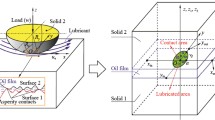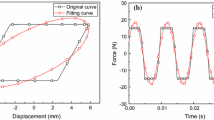Abstract
The present work envisaged the development of a novel method for computing the damping coefficients of thermal elastohydrodynamic lubricated point contacts based on energy conservation. The effects of load, entrainment velocity, and slide–roll ratio were studied, and the results were compared with the ISO thermal results. Multi-level method and discrete convolution fast Fourier transform method were employed to improve the solution convergence efficiency, and a sequential column sweeping technique was employed to solve the energy equations. The results indicated an increase in the damping coefficients with an increase in the load, and a corresponding decrease with an increase in the speed. When the entrainment velocity was relatively low, or the slide–roll ratio was relatively small, the influence of the slide–roll ratio was negligible. Subsequently, the relation between the damping coefficients and the load, speed, and slide–roll ratio was established using the least-square method.









Similar content being viewed by others
Abbreviations
- α :
-
Pressure–viscosity coefficient (Pa−1)
- β :
-
Temperature–viscosity coefficient (K−1)
- kf :
-
Lubricant thermal conductivity (W/mK)
- k a,b :
-
Solid thermal conductivities (W/mK)
- c f :
-
Lubricant specific heat (J/kgK)
- c a,b :
-
Solid specific heat (J/kgK)
- D :
-
Kernel elastic deformation
- T :
-
Temperature (K)
- T 0 :
-
Ambient temperature, 313 (K)
- η :
-
Viscosity of lubricant (Pa·s)
- η 0 :
-
Ambient viscosity of lubricant (Pa·s)
- ρ :
-
Density of lubricant (kg/m3)
- ρ 0 :
-
Ambient density of lubricant (kg/m3)
- ρ a,b :
-
Densities of solids ‘a’ and ‘b’ (kg/m3)
- b H :
-
Half-width of Hertzian contact zone (m)
- p :
-
Oil film pressure (Pa)
- p h :
-
Maximum Hertzian contact pressure (Pa)
- F 2 :
-
Elliptical integral of second kind
- E′:
-
Equivalent Young’s modulus (Pa)
- k e :
-
Elliptical ratio
- d :
-
Damping coefficient (N·s/m)
- H c :
-
Center film thickness (m)
- f :
-
Applied load (N)
- W 0 :
-
Dimensionless load, f/E′Rx2
- u,v :
-
Film velocities (m/s)
- u a,b :
-
Velocities of surfaces ‘a’ and ‘b’ (m/s)
- u e :
-
Entrainment velocity, (ua + ub)/2 (m/s)
- s :
-
Slide-roll ratio, (ua−ub)/ue
- u :
-
Entrainment velocity (m/s)
- U 0 :
-
Dimensionless velocity, uη0/E′Rx
- G 0 :
-
Material parameter, αE’′
- h :
-
Film thickness (m)
- δ :
-
Mutual approach (m)
- Δ:
-
Dimensionless mutual approach
- R x :
-
Ellipsoid radius in x-direction (m)
- R y :
-
Ellipsoid radius in y-direction (m)
- R :
-
Equivalent radius, 1/R = 1/Rx + 1/Ry
- x,y :
-
Coordinates (m)
- X,Y :
-
Dimensionless coordinates
- z :
-
Coordinate across the film (m)
- Z :
-
Dimensionless coordinate across the film
- z a,b :
-
Coordinates in solids ‘a’ and ‘b’ (m)
- Z a,b :
-
Dimensionless coordinates in solids
- t :
-
Time (s)
- ω:
-
Excitation frequency (rad/s)
References
Dareing DW, Johnson KL (1975) Fluid film damping of rolling contact vibrations. J Mech Eng Sci 17(4):214–218
Ankouni M, Lubrecht AA, Velex P (2016) Modelling of damping in lubricated line contacts-applications to spur gear dynamic simulations. Proc Inst Mech Eng Part C-J Mech Eng Sci 230(7–8):1222–1232. https://doi.org/10.1177/0954406216628898
Dietl P, Wensing J, van Nijen GC (2000) Rolling bearing damping for dynamic analysis of multi-body systems—experimental and theoretical results. Proc Inst Mech Eng Part K-J Multi-body Dyn 214(1):33–43. https://doi.org/10.1243/1464419001544124
Vinuesa R, Bartrons E, Chiu D, Dressler KM, Ruedi JD, Suzuki Y, Nagib HM (2014) New insight into flow development and two dimensionality of turbulent channel flows. Exp Fluids. https://doi.org/10.1007/s00348-014-1759-8
Chu CS, Wood KL, Busch-Vishniac IJ (1998) A nonlinear dynamic model with confidence bounds for hydrodynamic bearings. J Tribol Trans Asme 120(3):595–604. https://doi.org/10.1115/1.2834592
Sarangi M, Majumdar BC, Sekhar AS (2004) Stiffness and damping characteristics of lubricated ball bearings considering the surface roughness effect. Part 2: numerical results and application. Proc Inst Mech Eng Part J J Eng Tribol 218(J6):539–547. https://doi.org/10.1243/1350650042794734
Sarangi M, Majumdar BC, Sekhar AS (2005) On the dynamics of elastohydrodynamic mixed lubricated ball bearings. Part II: non-linear structural vibration. Proc Inst Mech Eng Part J-J Eng Tribol 219(6):423–433. https://doi.org/10.1243/135065005x34080
Zhou CJ, Xiao ZL (2018) Stiffness and damping models for the oil film in line contact elastohydrodynamic lubrication and applications in the gear drive. Appl Math Model 61:634–649. https://doi.org/10.1016/j.apm.2018.05.012
Xiao ZL, Li ZD, Shi X, Zhou CJ (2018) Oil film damping analysis in Non Newtonian transient thermal elastohydrodynamic lubrication for gear transmission. J Appl Mechan-Trans Asme. https://doi.org/10.1115/1.4038697
Wijnant YH, Venner CH Contact Dynamics in Starved Elastohydrodynamic Lubrication. In: Tribology Series, 1999. Elsevier, pp 705–716. https://doi.org/10.1016/S0167-8922(99)80089-3
Wijnant YH (1998) Contact dynamics in the field of elastohydrodynamic lubrication. Ph. D Thesis, Universiteit Twente, The Netherlands
Wijnant YH, Wensing JA, Van Nijen GC (1999) The influence of lubrication on the dynamic behaviour of ball bearings. J Sound Vib 222(4):579–596. https://doi.org/10.1006/jsvi.1998.2068
Nonato F, Cavalca KL (2010) On the non-linear dynamic behavior of elastohydrodynamic lubricated point contact. J Sound Vib 329(22):4656–4671. https://doi.org/10.1016/j.jsv.2010.05.014
Zhang YY, Liu HJ, Zhu CC, Liu MY, Song CS (2016) Oil film stiffness and damping in an elastohydrodynamic lubrication line contact-vibration. J Mech Sci Technol 30(7):3031–3039. https://doi.org/10.1007/s12206-016-0611-x
Yu-Yan Zhang X-LW, Yan Xiao-Liang (2013) Dynamic Behaviors of the Elastohydrodynamic Lubricated Contact for Rolling Bearings. J Tribol 135(2):8. https://doi.org/10.1115/1.4023084
Li LL, Yang JJ (2018) A study of dynamic behaviors of contact pair in lubricated ball linear guide. Ind Lubr Tribol 70(4):746–753. https://doi.org/10.1108/ilt-07-2017-0198
Peiran Y, Shizhu W (1990) A generalized Reynolds equation for Non-Newtonian thermal elastohydrodynamic lubrication. Journal of Tribology-Transactions of the Asme 112(4):631–636. https://doi.org/10.1115/1.2920308
Venner C (1991) Multilevel solution of the EHL line and point contact problems. Ph. D. Thesis, Department of Mechanical Engineering, University of Twente, Enschede, The Netherlands
Shuangbiao L, Qian W, Geng L (2000) A versatile method of discrete convolution and FFT (DC-FFT) for contact analyses. Wear 243(1–2):101–111
Guo F, Yang PR (1999) Influence of a ring flat zone in the point contact surface on thermal elastohydrodynamic lubrication. Tribol Int 32(3):167–175. https://doi.org/10.1016/s0301-679x(99)00041-9
Hamrock BJ, Dowson D (1977) Isothermal elastohydrodynamic lubrication of point contacts. 4 .Starvation results. J Lubricat Technol-Trans Asme 99(1):15–23
Rezaeiravesh S, Vinuesa R, Liefvendahl M, Schlatter P (2018) Assessment of uncertainties in hot-wire anemometry and oil-film interferometry measurements for wall-bounded turbulent flows. Eur J Mechan B-Fluids 72:57–73. https://doi.org/10.1016/j.euromechflu.2018.04.012
Acknowledgments
This work was supported financially by the Natural Science Basic Research Plan in Shaanxi Province of China (Program No. 2019JM535).
Author information
Authors and Affiliations
Corresponding author
Additional information
Technical Editor: Wallace Moreira Bessa, D.Sc..
Publisher's Note
Springer Nature remains neutral with regard to jurisdictional claims in published maps and institutional affiliations.
Rights and permissions
About this article
Cite this article
Dong, G. Damping characteristics of thermal elastohydrodynamic lubricated point contacts. J Braz. Soc. Mech. Sci. Eng. 43, 137 (2021). https://doi.org/10.1007/s40430-021-02842-8
Received:
Accepted:
Published:
DOI: https://doi.org/10.1007/s40430-021-02842-8




